Between
Page 42
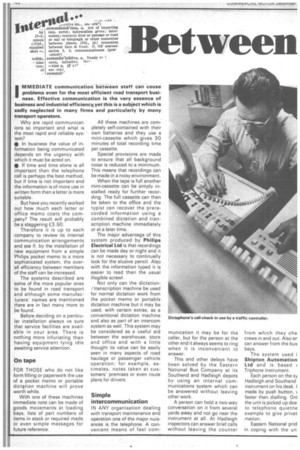
Page 43
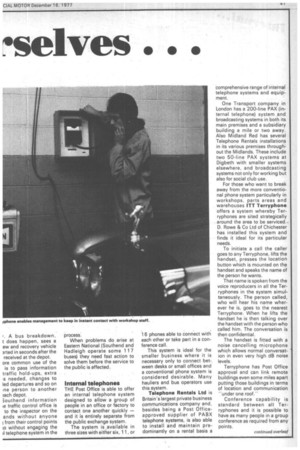
Page 44
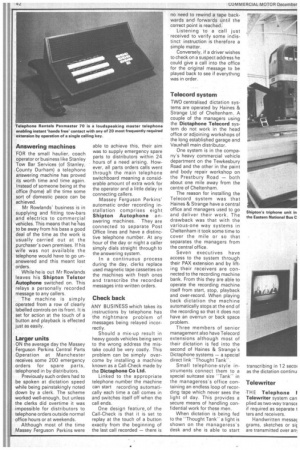
Page 45
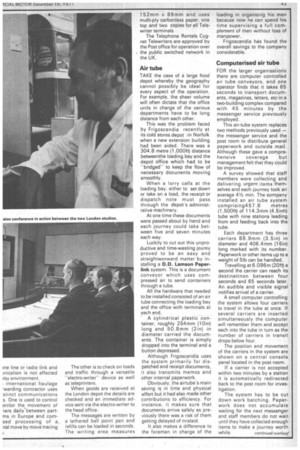
Page 46
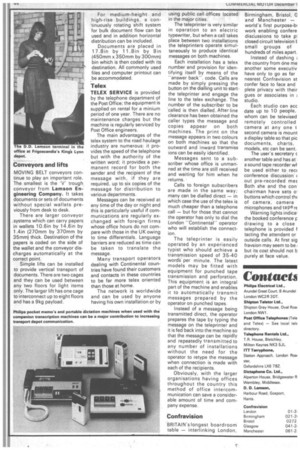
If you've noticed an error in this article please click here to report it so we can fix it.
!selves • • •
IMMEDIATE communication between staff can cause problems even for the most efficient road transport business. Effective communication is the very essence of business and industrial efficiency,yet this is a subject which is sadly neglected in many firms and particularly by many
transport operators. . .
Why are rapid communications so important and what is the most rapid and reliable system?
• In business the value of information being communicated depends on the urgency with which it must be acted on.
• If time and time alone is all important then the telephone call is perhaps the best method, but if time is not important and the information is of more use in written form then a letter is more. suitable.
But have you recently worked out how much each letter or office memo costs the corn.rpany? The result will probably be a staggering £3.50.
Therefore it is up to each company to review its internal communication arrangements and see if, by the installation of new equipment from a simple Philips pocket memo to a more sophisticated system, the overall efficiency between members of the staff can be ,increased.
The systems described are some of the more popular ones to be found in road transport and although some manufacturers' names are mentioned there are in fact many more to be found.
Before deciding on a particular installation always ye sure that service facilities are available in your area. There is nothing more infuriating than having equipment lying idle awaiting service attention.
On tape
FOR THOSE who do not like form filling or paperwork the use of a pocket memo or portable dictation machine will prove worth while.
With one of these machines immediate note can be made of goods movements at loading bays, lists of part numbers of items in stock or required made or even simple messages for future reference. All these machines are completely self-contained with their own batteries and they use a mini-cassette which gives 30 minutes of total recording time per cassette.
Special provisions are made to ensure that all background noise is reduced to a minimum. This means that recordings can be made in a noisy environment.
When the tape is full another mini-cassette can be simply installed ready for further recording. The full cassette can then be taken to the office and the typist can recover the prerecorded information using a combined dictation and transcription machine immediately or at a later time.
The major advantage of this system produced by Philips Electrical Ltd is that recordings can be made day or night and it is not necessary to continually look for the elusive pencil. Also with the information typed it is easier to read than the usual illegible scrawl.
Not only can the dictation/transcription machine be used for normal dictation work from the pocket memo or portable dictation machine but it may be used, with certain extras, as a conventional dictation machine and also as part of an intercom system as well. This system may be considered as a useful aid between the warehouse, store and office and with a little thought its value can be easily seen in many aspects of road haulage or passenger vehicle operation; for example, estimates, notes taken at customers' premises or even route plans for drivers.
Simple intercommunication
IN ANY organisation dealing with transport maintenance and operation one of the major nuisances is the telephone. A convenient means of fast corn munication it may be for the caller, but for the person at the other end it always seems to ring when it is inconvenient to answer.
This and other delays have been solved by the Eastern National Bus Company at its Southend and Hadleigh depots by using an internal communications system which can be answered without leaving other work.
A person can hold a two-way conversation on it from several yards auVay and not go near the instrument at all. At Hadleigh inspectors can answer brief calls without leaving the counter from which they che crews in and out. Also en can answer from the bus bays.
The system used i Shipton Automation Ltd and is based c Triphone instrument.
Each person on the s,j/ Hadleigh and Southend instrument on his desk. I made by push button, s. faster than dialling. Onl the unit is picked up doe to telephone quietne example to give privat mation.
Eastern National prid in coping with the un• ,. A bus breakdown, t does happen, sees a ew and recovery vehicle 3rted in seconds after the received at the depot. ore common use of the is to pass information traffic hold-ups, extra s needed, changes to led departures and so on ne person to another )ach depot.
3outhend information ie traffic control office is to the inspector on the ands without anyone I from their control points ;o without engaging the il telephone system in the process.
When problems do arise at Eastern National (Southend and Hadleigh operate some 1'17 buses) they need fast action to solve them before the service to the public is affected.
Internal telephones THE Post Office is able to offer an internal telephone system designed to allow a group of people in an office or factory to contact one another quickly — and it is entirely separate from the public exchange system.
The system is available in three sizes with either six, 11, or 16 phones able to connect with each other or take part in a conference call.
This system is ideal for the smaller business where it is necessary only to connect bet-. ween desks or small offices and a conventional phone system is considered desirable. Many hauliers and bus operators use this system.
Telephone Rentals Ltd is Britain's largest private business communications company and, besides being a Post Officeapproved supplier of PABX telephone systems, is also able to install and maintain predominantly on a rental basis a comprehensive range of internal telephone systems and equipment.
One Transport company in London has a 200-line PAX (internal telephone) system and broadcasting systems in both its main premises and a subsidiary building a mile or two away. Also Midland Red has several Telephone Rentals installations in its various premises throughout the Midlands. These include two 50-line PAX systems at Digbeth with smaller systems elsewhere, and broadcasting systems not only for working but also for social club use.
For those who want to break away from the more conventional phone system particularly in workshops, parts areas and warehouses ITT Terryphone offers a system whereby Terryphones are sited strategically around the area to be serviced.. D. Rowe & Co Ltd of Chichester has installed this system and finds it ideal for its particular needs.
To initiate a call the caller goes to any Terryphone, lifts the handset, presses the location button which is mounted on the handset and speaks the name of the person he wants.
That name is spoken from the voice reproducers in all the Terryphones in the system simultaneously. The person called, who will hear his name wherever he is, goes to the nearest Terryphone. When he lifts the handset he is then talking over the handset with the person who called him. The conversation is then confidential.
The handset is fitted with a noise cancelling microphone which allows normal conversation in even very high dB noise levels.
Terryphone has Post Office approval and can link remote buildings even some miles apart putting those buildings in terms of location and communication ' under one roof."
Conference capability is standard between all Terryphones and it is possible to have as many people in a group conference as required from any points.
Answering machines
FOR the small haulier, coach operator or business like Stanley Tow Bar Services (of Stanley, • County Durham) a telephone answering machine has proved its worth time and time again. Instead of someone being at the office (home) all the time some sort of domestic peace can be achieved.
Mr Rowlands' business is in supplying and fitting tow-bars and electrics to commercial 'vehicles. This means that he-has to be away from his base a good deal of the time as the work is usually carried out at the purchaser's own premises. If his wife was not available the telephone would have to go unanswered and this meant lost orders.
While he is out Mr Rowlands leaves his Shipton Telstor Autophone switched on. This relays a personally recorded message to any callers.
• The machine is simply operated from a row of clearly labelled controls on its front. It is set for action at the touch of a button and playback is effected just as easily.
• Larger units
ON the average day the Massey Ferguson Perkins Central Parts Operation at Manchester receives some 200 emergency orders for spare parts, telephoned in by distributors.
Previously such orders had to be spoken at dictation speed while being painstakingly noted down by a clerk. The scheme worked well-enough, but unless the clerks did overtime it was impossible for distributors to telephone orders outside normal office hours or at weekends.
Although most of the time Massey Ferguson Perkins were able to achieve this, their aim was to supply emergency spare parts to distributors within 24 hours of a need arising. However, all parts orders calls went through the main telephone switchboard meaning a considerable amount of extra work for the operator and a little delay in connecting callers.
Massey Ferguson Perkins' automatic order recording installation comprises eight Shipton Autophone answering machines. They are connected to separate Post Office lines and have a distinctive telephone number. At any hour of the day or night a caller simply dials straight through to the answering system.
In a continuous process during the day, clerks replace used magnetic tape cassettes on the machines with fresh ones and transcribe the recorded messages into written orders.
Check back
ANY BUSINESS which takes its _instructions by telephone has the nightmare problem of messages being relayed incorrectly.
Should a mix-up result in heavy goods vehicles being sent to the wrong address the mistake could be very costly. This problem can be simply overcome by installing a machine known as a Call-Check made by the Dictaphone Co Ltd.
Linked to the appropriate telephone number the machine can start recording automatically each time a call comes in and switches itself off when the call ends.
One design feature...of the Call-Check is that it is set to replay at the touch of a button exactly from the beginning of the last call recorded — there is no need to rewind a tape backwards and forwards until the correct point is reached.
Listening to a call just received to verify some indistinct instruction is therefore a simple matter.
Conversely, if a driver wishes to check on a suspect address he could give a call into the office for the original message to be played back to see if everything was in order.
Telecord system TWO centralised dictation systems are operated by Haines & Strange Ltd of Cheltenham. A couple of the managers using the Dictaphone Telecord system do not work in the head office or adjoining workshops of the long established garage and Vauxhall main distributor.
One system is in the company's heavy commercial vehicle department on the Tewkesbury Road and the other in the paint and body repair workshop on the Prestbury Road — both about one mile away from the centre of Cheltenham.
The reason for installing the Telecord system was that Haines & Strange have a central office and managers used to go and deliver their work. The drawback was that with the various-one way systems in Cheltenham it took some time to cover the mile or so that separates the managers from the central office.
Seven executives have access to the system through their PAX extension and by lifting their receivers are connected to the recording machine bank. From this they are able to operate the recording machine itself from start, stop, playback and over-record. When playing back dictation the machine automatically stops at the end of the recording so that it does not have an overrun or back space problem.
Three members of senior management also have Telecord extensions although most of their dictation is fed into the second of Haines & Strange's Dictaphone systems — a special direct link "Thought Tank".
Small telephone-style instruments connect them to a special suitcase size ''Tank" in the manageress's office containing an endless loop of recording tape which never sees the light of day. This provides a secure means of handling confidential work for these men.
When dictation is being fed to the "Thought Tank" a light is shown on the manageress's desk and she is able to start transcribing in 12 sem as the dictation continu
Telewriter
E Telephone I Telewriter system can plied as two-way transcE if required as separate t ters and receivers.
Handwritten messai grams, sketches or s4 are transmitted over am
me line or radio link and lnication is not affected iisy environment.
international haulage -warding contractor uses stinct communications s. One is used to control onitor the. movement of iers daily between partms in Europe and cornsed processing of a, )tal move by move tracing The other is to check on loads and traffic through a versatile "electro-writerdevice as well as teleprinters.
When goods are received at the London depot the details are checked and an immediate advice sent via the electro-writer to the head office, The messages are written by a tethered ball point pen and refills can be loaded in seconds. The writing area measures 152mm x 89mm and uses carbonless paper, one top and two copies for all Telewriter terminals The Telephone Rentals Cygnet Telewriters are approved by the Post office for operation over • the public switched network in the UK.
Air tube
TAKE the case of a large food depot whereby the geography cannot possibly be ideal for every aspect of the operation. For example, the sheer volume will often dictate that the office units in charge of the various departments have to be long distance from each other.
This was the problem faced by Frigoscandia recently at its cold stores depot in Norfolk when a new extension building had been aided. There was a 304.8 metre (1,000ft) distance betweenthe loading bay and the depot office which had to be "bridged" to keep the flow of necessary docunents moving smoothly.
When a lorry calls at the loading bay, either to set down or take on a load, the receipt or dispatch note must pass through the depot's administrative machinery.
At one time these documents were passed about by hand and each journey could take between five and seven minutes each way.
.Luckily to cut out this unproductive and time-wasting jourey proved to be an easy and straightworward matter by installing a D.D. Lamson Paperlink system. This is a document conveyor which uses compressed air to send containers through a tube.
All the hardware that needed to be installed consisted of an air tube connecting the loading bay and the office with terminals at each end.
A cylindrical plastic container, roughly 254mm (10in) long and 50.8mm (2in) in diameter carried the documents. The container is simply dropped into the terminal and a button depressed.
Although Frigoscandia uses the system primarily for dispatched and receipt documents, it also transmits memos and other internal paperwork.
Obviously, the airtube's main saving is in time and physical effort but it had also made other contributions to efficiency. For instance, it makes sure that documents arrive safely as previously there was a risk of them getting delayed of mislaid.
It also makes a difference to the foreman in charge Of the
loading in organising his men because now he can spend his time supervising a full complement of men without loss of manpower.
Frigoscandia has found the overall savings to the company considerable.
Computerised air tube
FOR the larger organisations there are computer controlled air tube conveyors, and one operator finds that it takes 65 seconds to transport documents, magazines, letters, etc in a two-building complex compared with 45 minutes by the. messenger service previously employed.
This air-tube system replaces two methods previously used — the messenger service and the post room to distribute general' paperwork and outside mail. Although these gave a compre hensive coverage but management felt that they could be improved.
A survey showed that staff members were collecting and delivering urgent items themselves and each journey took an average 41/2 min. The company installed an air tube system comprising457.8 metres (1,500ft) of 114.3mm (4.5inh) tube with nine stations leading from and feeding back into the tube.
Each department has three carriers 88.9mm (3.5in) in diameter and 406.4mm (16in) long marked with its number. Paperwork or other items up to a weight of 5Ib can be handled.
Travelling at 6.096m (20ft) a second the carrier can reach its deStinatinon between four seconds and 65 seconds later. An audible and visible signal notifies arrival of a carrier.
A small computer controlling the system allows four carriers to travel in the tube at once. If several carriers are inserted simultaneously the computer will remember them and accept each into the tube in turn as the number of carriers in transit drops below four.
The position and movement of the carriers in the system are shown on a central console panel located in the post room.
If a carrier is not accepted within two minutes by a station it is automatically redirected back to the post room for investigation.
The system has to be cut down work batching. Paper work does not accumulate waiting for the next messenger and staff members do not wait until they have collected enough items to make a journey worth
while. continued ovetleaf Conveyors and lifts MOVING BELT conveyors continue to play an important role. The smallest is the 'V' trough. conveyor from Lamson Engineering Company. It takes documents or sets of documents without special wallets previously from desk to desk.
There are larger conveyor ,systems which can carry papers in wallets 10.6in by 14.6in by 1.4in (270mm by 370mm by 35mm) thick. Destination of the papers is coded on the side of the wallet and the conveyor discharges automatically at the correct point.
Simple lifts can be installed to provide vertical transport of documents. There are two cages and they can be used between any two floors for light items only. The larger lift has one cage to interconnect up to eight floors and has a 9kg payload. For medium-height and high-rise buildings, a continuously rotating shift system for bulk document flow can be used and in addition horizontal distribution can be included.
Documents are placed in 17,8in by 11.8in by 9in (450mm x 350mm by 300mm) bin which is then coded with its destination. All commonly used files and computer printout can be accommodated.
Telex TELEX SERVICE is provided by the telephone department of the Post Office; the equipment is supplied on rental for a minium period of one year. There are no maintenance charges but the machine is regularly serviced by Post Office engineers.
The main advantages of the telex system to the road haulage industry are numerous: it provides the speed of the telephone but with the authority of the written word; it provides a permanent record for both the sender and the recipient of the message with, if they are required, up to six copies of the message for distribution to various departments.
Messages can be received at any time of the day or night and this is particularly useful if communications are regularly exchanged with foreign firms whose office hours do not compare with those in the UK owing to time differentials. Language barriers are reduced as time can be taken to translate the message.
Many transport operators dealing with Continental countries have found their customers and contacts in these countries to be far more telex oriented than those at home.
The network is worldwide and can be used by anyone having his own installation or by using public call offices located in the major cities.
The teleprinter is very similar in operation to an electric typewriter, but when a call takes place between two installations the teleprinters operate simultaneously to produce identical messages on both machines.
Each installation has a telex number and provision for identifying itself by means of the "answer back". code. Calls are made by simply pressing the button on the dialling unit to start• the teleprinter and engage the line to the telex exchange. The number of the subscriber to be called is then dialled. After line clearance has been obtained the caller types the message and copies appear on both machines. The print on the message appears in two colours on both machines so that the outward and inward transrniss ions can be easily identified.
Messages sent to a subscriber whose office is unmanned at the time are still received and waiting for him when he returns. • Calls to foreign subscribers are made in the same way; many can be dialled direct — in which case the use of the telex is much cheaper than a telephone call — but for those that cannot the operator has only to dial the London "Continental" operator who will establish the connection.
The teleprinter is easily operated by an experienced typist who should achieve a transmission speed of 35-40 words per minute. The latest models may be fitted with equipment for punched tape transmission and perforation. This equipment is an integral part of the machine and enables it to automatically transmit messages prepared by the operator on punched tapes.
Instead of a message being transmitted direct, the operator prepares the tape by typing the message on the teleprinter and it is fed back into the machine so that the message can be rapidly and repeatedly transmitted to any number of installations without the need for the operator to retype the message when connection is made with each of the recipients.
Obviously, with the larger organisations having offices throughout the country this method of office intercommunication can save a considerable amount of time and company expense.
Confravision
BRITAIN's longest boardroom table — interlinking London, Birmingham, Bristol, G and Manchester — world's first purpose-bi work enabling confere discussions to take pl closed circuit television t small groups of hundreds of miles apart.
Instead of dashing the country from one me another some executiv have only to go as far nearest Confravision st confer face to face and plete privacy with their gues or associates in i studio.
Each studio can acc date up to 10 people, whom can be televised remotely controlled camera at any one t second camera is mount a display table so that pic documents, charts, models, etc can be sent.
The user's secretary c another table and has at a sound tape recorder wf be used either to I'm conference discussion c out pre-recorded met Both she and the con. chairman have sets o. buttons which control thf of camera, camera microphones and tape rE
Warning lights indica' the booked conference p drawing to a close telephone is provided f tacting the attendant or outside calls. At first sig fravsion may seem to be but its cost should not b purely at face value.




























































































